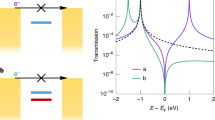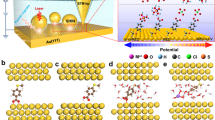Abstract
In recent years, various single-molecule electronic components have been demonstrated1. However, it remains difficult to predict accurately the conductance of a single molecule and to control the lateral coupling between the π orbitals of the molecule and the orbitals of the electrodes attached to it. This lateral coupling is well known to cause broadening and shifting of the energy levels of the molecule; this, in turn, is expected to greatly modify the conductance of an electrode–molecule–electrode junction2,3,4,5,6. Here, we demonstrate a new method, based on lateral coupling, to mechanically and reversibly control the conductance of a single-molecule junction by mechanically modulating the angle between a single pentaphenylene molecule bridged between two metal electrodes. Changing the angle of the molecule from a highly tilted state to an orientation nearly perpendicular to the electrodes changes the conductance by an order of magnitude, which is in qualitative agreement with theoretical models of molecular π-orbital coupling to a metal electrode. The lateral coupling is also directly measured by applying a fast mechanical perturbation in the horizontal plane, thus ruling out changes in the contact geometry or molecular conformation as the source for the conductance change.
This is a preview of subscription content, access via your institution
Access options
Subscribe to this journal
Receive 12 print issues and online access
$259.00 per year
only $21.58 per issue
Buy this article
- Purchase on Springer Link
- Instant access to full article PDF
Prices may be subject to local taxes which are calculated during checkout






Similar content being viewed by others
References
Tao, N. J. Electron transport in molecular junctions. Nature Nanotech. 1, 173–181 (2006).
Kornilovitch, P. E. & Bratkovsky, A. M. Orientational dependence of current through molecular films. Phys. Rev. B 64, 195413 (2001).
Bratkovsky, A. M. & Kornilovitch, P. E. Effects of gating and contact geometry on current through conjugated molecules covalently bonded to electrodes. Phys. Rev. B 67, 115307 (2003).
Geng, W. T., Nara, J. & Ohno, T. Impacts of metal electrode and molecule orientation on the conductance of a single molecule. Appl. Phys. Lett. 85, 5992–5994 (2004).
Haiss, W. et al. Precision control of single-molecule electrical junctions. Nature Mater. 5, 995–1002 (2006).
Basch, H., Cohen, R. & Ratner, M. A. Interface geometry and molecular junction conductance: geometric fluctuation and stochastic switching. Nano Lett. 5, 1668–1675 (2005).
Toyoda, K., Morimoto, K. & Morita, K. First-principles study on current through a single π conjugate molecule for analysis of carrier injection through an organic/metal interface. Surf. Sci. 600, 5080–5083 (2006).
Wang, L., Liu, L., Chen, W., Feng, Y. & Wee, A. T. S. Configuration-dependent interface charge transfer at a molecule–metal junction. J. Am. Chem. Soc. 128, 8003–8007 (2006).
Temirov, R., Lassise, A., Anders, F. B. & Tautz, F. S. Kondo effect by controlled cleavage of a single-molecule contact. Nanotechnology 19, 065401 (2008).
Lafferentz, L. et al. Conductance of a single conjugated polymer as a continuous function of its length. Science 323, 1193–1197 (2009).
Kamenetska, M. et al. Conductance and geometry of pyridine-linked single-molecule junctions. J. Am. Chem. Soc. 132, 6817–6821 (2010).
Quek, S. Y. et al. Mechanically controlled binary conductance switching of a single-molecule junction. Nature Nanotech. 4, 230–234 (2009).
Kamenetska, M. et al. Formation and evolution of single-molecule junctions. Phys. Rev. Lett. 102, 126803 (2009).
Venkataraman, L., Klare, J. E., Nuckolls, C., Hybertsen, M. S. & Steigerwald, M. L. Dependence of single-molecule junction conductance on molecular conformation. Nature 442, 904–907 (2006).
Hines, T. et al. Transition from tunneling to hopping in single molecular junctions by measuring length and temperature dependence. J. Am. Chem. Soc. 132, 11658–11664 (2010).
Wu, S. M. et al. Molecular junctions based on aromatic coupling. Nature Nanotech. 3, 569–574 (2008).
Xu, B. & Tao, N. J. Measurement of single-molecule resistance by repeated formation of molecular junctions. Science 301, 1221–1223 (2003).
Li, X., He, J., Hihath, J., Xu, B., Lindsay, S. M. & Tao, N. J. Conductance of single alkanedithiols: conduction mechanism and effect of molecule–electrode contacts. J. Am. Chem. Soc. 128, 2135–2141 (2006).
Huang, Z., Chen, F., Bennett, P. A. & Tao, N. J. Single molecule junctions formed via Au–thiol contact: stability and breakdown mechanism. J. Am. Chem. Soc. 129, 13225–13231 (2007).
Haiss, W. et al. Measurement of single molecule conductivity using the spontaneous formation of molecular wires. Phys. Chem. Chem. Phys. 6, 4330–4337 (2004).
Xia, J. L., Diez-Perez, I. & Tao, N. J. Electron transport in single molecules measured by a distance-modulation assisted break junction method. Nano Lett. 8, 1960–1964 (2008).
Perrine, T. M. & Dunietz, B. D. Carbonyl mediated conductance through metal bound peptides: a computational study. Nanotechnology 18, 424003 (2007).
Li, Z. & Kosov, D. S. Nature of well-defined conductance of amine-anchored molecular junctions: density functional calculations. Phys. Rev. B 76, 035415 (2007).
Li, C. et al. Charge transport in single Au/alkanedithiol /Au junctions: coordination geometries and conformational degrees of freedom. J. Am. Chem. Soc. 130, 318–326 (2008).
Acknowledgements
The authors acknowledge support from the Office of Basic Energy Sciences, US Department of Energy (grant DE-FG03-01ER45943). I.D.-P. thanks the EU International Outgoing Marie Curie Programme for financial support.
Author information
Authors and Affiliations
Contributions
N.J.T. conceived the transport experiment. I.D.-P., J.H. and T.H. conducted the experiments and analysed the data. K.M. supervised the design and synthesis of the molecule. Z.-S.W. and G.Z. synthesized the molecule.
Corresponding authors
Ethics declarations
Competing interests
The authors declare no competing financial interests.
Supplementary information
Supplementary information
Supplementary information (PDF 1322 kb)
Rights and permissions
About this article
Cite this article
Diez-Perez, I., Hihath, J., Hines, T. et al. Controlling single-molecule conductance through lateral coupling of π orbitals. Nature Nanotech 6, 226–231 (2011). https://doi.org/10.1038/nnano.2011.20
Received:
Accepted:
Published:
Issue Date:
DOI: https://doi.org/10.1038/nnano.2011.20
This article is cited by
-
Controlling piezoresistance in single molecules through the isomerisation of bullvalenes
Nature Communications (2023)
-
Nanoscale molecular rectifiers
Nature Reviews Chemistry (2023)
-
Mechanical single-molecule potentiometers with large switching factors from ortho-pentaphenylene foldamers
Nature Communications (2021)
-
Gate-controlled conductance switching in DNA
Nature Communications (2017)
-
Conductance saturation in a series of highly transmitting molecular junctions
Nature Materials (2016)



